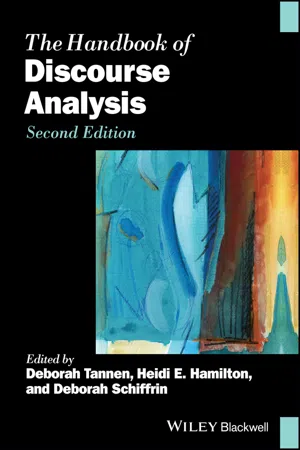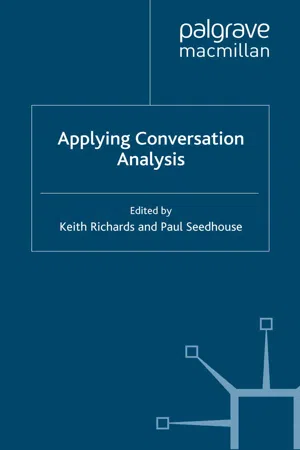Languages & Linguistics
Drew and Heritage Institutional Talk
The "Drew and Heritage Institutional Talk" refers to a type of conversation analysis that focuses on the interactional practices within institutional settings. It examines how participants in institutional talk manage their roles, responsibilities, and power dynamics through language use. This approach sheds light on the ways in which language shapes and reflects social structures and relationships within institutional contexts.
Written by Perlego with AI-assistance
Related key terms
1 of 5
5 Key excerpts on "Drew and Heritage Institutional Talk"
- eBook - ePub
Language and Power
A Resource Book for Students
- Paul Simpson, Andrea Mayr, Simon Statham(Authors)
- 2018(Publication Date)
- Routledge(Publisher)
This contrasts with ordinary conversation between speakers of roughly the same status. Institutional settings include the courtroom, business meetings, service encounters, doctor–patient consultations or classroom interaction, and in such settings, there is at least one participant who may restrict the contributions of the other participant. Drew and Heritage sum up the features of institutional talk as follows:- Institutional interaction involves an orientation by at least one of the participants to some core goal, task or activity (or set of them) conventionally associated with the institution in question. In short, institutional talk is normally informed by goal orientations of a relatively restricted conventional form.
- Institutional interaction may often involve special and particular constraints on what one or both of the participants will treat as allowable contributions to the business at hand.
- Institutional talk may be associated with inferential frameworks and procedures that are particular to specific institutional contexts.
This means that in practice interactions in institutional settings have a very specific goal and are often asymmetrical in their distribution of speaking rights and obligations. Courtroom interaction is a particularly marked form of institutional discourse (as we shall see in Strand 7) and many of Drew and Heritage’s criteria are borne out in an influential study by Harris on the linguistic structure of interactions in a magistrate’s court (1984; see also Cameron 2001). For feature 1 of institutional talk, goal orientation , Harris observed how the goal was eliciting answers from the defendants through a series of questions about non-payment of fines, as in:M: How much do you earn a week? D: I don’t earn any determinate amount.(Harris 1984: 18)As for feature 2, one particular constraint - eBook - ePub
Interlanguage Pragmatics
Exploring Institutional Talk
- Kathleen Bardovi-Harlig, Beverly S. Hartford(Authors)
- 2005(Publication Date)
- Routledge(Publisher)
Institutional discourse can also be investigated for its own sake within interlanguage pragmatics because of the number of nonnative speakers who may be involved in such events. We have argued that the information gained from the analysis of institutional discourse has practical application. It is a type of discourse that almost all second language learners will have to engage in in the real world at some point in their learning histories. Pedagogical usages can be developed which will be meaningful to the learners' lives. Although not all learners will encounter all institutional events, there are some which may be seen as occurring and recurring for them and for which they can acquire some expertise.Finally, although the investigation of institutional talk is not a substitute for the examination of casual conversation which interlanguage pragmatics studies will eventually need to undertake, it can lead to fruitful investigation on a number of planes for interlanguage pragmatics research. Furthermore, it will help bring interlanguage pragmatics research in line with work already being carried out by other discourse analysts. Clearly, the amount of research focusing on the discourse of institutional talk which is done from frameworks other than interlanguage pragmatics suggests that it is an important and promising area for such research. There is every reason to believe that the same holds true for interlanguage pragmatics research.1 Drew and Heritage (1992) covers a wide range of these settings, as does Sarangi and Roberts (1999).2 Although most of this work investigates face-to-face oral discourse, there is some work on written institutional discourse, particularly on business writing (Moran & Moran, 1985; Yli-Jokipii 1991).3 - eBook - PDF
- Deborah Tannen, Heidi E. Hamilton, Deborah Schiffrin(Authors)
- 2015(Publication Date)
- Wiley-Blackwell(Publisher)
Many of Drew and Heritage’s criteria are borne out by numerous studies on insti- tutional interactions, such as in the courtroom (Atkinson and Drew 1979; Harris 1984), police interrogations (Stokoe and Edwards 2008), news interviews (Heritage and Clayman 2010), and doctor–patient interactions (Stivers 2007). To select an example from courtroom discourse, Harris’s (1984) study on the linguistic structure of interac- tions in a British magistrate’s court shows that the goal orientation in the courtroom was to elicit answers from the defendants through a series of questions about non-payment of fines, as in: M: How much do you earn a week? D: I don’t earn any determinate amount. (Harris 1984: 18) One particular constraint Harris observed was the turn-taking system that operated in the courtroom. Defendants were not allowed to ask questions. If they did, they were reprimanded by the magistrate for the inappropriateness of their conduct, as in: 764 Andrea Mayr M: I’m putting it to you again – are you going to make an offer – uh – uh to discharge this debt? D: Would you in my position? M: I – I’m not here to answer questions – you answer my question. (Harris 1984: 5) The third characteristic of institutional talk, associated with certain inferential frame- works, suggests that people who are engaged in institutional interactions interpret utterances in a way they might not in other circumstances. In Harris’s study, questions were not asked as straightforward requests for information; rather they functioned as accusations in the courtroom context: M: How much money have you got on you? D: I haven’t got any on me your worships M: How’d you get here? D: I uh got a lift — part way here (Harris 1984: 5) Here the Magistrate’s two questions carry with them the accusation that the defendant has been lying about not having any money and that he must have money because he paid to travel to court. - eBook - PDF
- K. Richards, P. Seedhouse, K. Richards, P. Seedhouse(Authors)
- 2016(Publication Date)
- Palgrave Macmillan(Publisher)
Ethnomethodologically based studies of social identity (e.g. Antaki and Widdicombe (eds) 1998) claim that participants can adopt multiple social identities. From this perspective, Drew and Heritage (1992b) characterize talk-in-interaction as institutional insofar as participants orient to their professional or institutional identities. Drawing upon Membership Categorization Analysis, this article reveals that the institutional nature of the service encounters under analysis lies not only in the participants’ enacting of institutional identities but also in their navigation (Gafaranga 2001) between these institutional identities and others made relevant in the course of the interaction. In bi/multilingual service talk-in-interaction, one such set of identities is that of linguistic identities (Gafaranga 2001; Torras 2002; Torras and Gafaranga 2002). This study is based on a corpus of Castilian/Catalan/English service encounters audio-recorded in a number of service settings in Barcelona, where the use of any of the three languages is possible. Catalan and Castilian constitute equally legitimate choices on account of their K. Richards et al. (eds.), Applying Conversation Analysis © Palgrave Macmillan, a division of Macmillan Publishers Limited 2005 108 Applying Conversation Analysis co-official status in Catalonia. Because of the foreign/international nature of the settings, a third possible language choice is English, although occasionally another foreign language may be used. 1 The chapter first introduces some basic theoretical notions and claims on which this study draws, then discusses the participants’ negotiation of social identities in the opening turns of their interaction. This concentrates on the three main categorization devices to which participants in my data evoke occasioned membership, namely service parties, acquaintanceship and language preference. - eBook - PDF
Dialogue Analysis VII: Working with Dialogue
Selected Papers from the 7th IADA Conference, Birmingham 1999
- Malcolm Coulthard, Janet Cotterill, Frances Rock, Malcolm Coulthard, Janet Cotterill, Frances Rock(Authors)
- 2017(Publication Date)
- De Gruyter(Publisher)
References Clayman, S. (1993): Reformulating the question: A device for answering / not answering questions in news interviews and press conferences. Text 13 (2), 159-188. Drew, P. and J. Heritage (1992): Talk at Work. Interaction in Institutional Settings. Cambridge: CUP. Drew, P. and E. Holt (1998): Figures of speech: Figurative expressions and the management of topic transition in conversation. Language in Society 27, 495-523. French, P. and Local, J. (1983): 'Turn-competitive incomings'. Journal of Pragmatics 7, 17-38. Interjections and the Institutionality of Broadcast Talk 105 Goodwin, C. (1986): Audience diversity, participation and interpretation. Text 6 (3), 283-316. Goodwin, C. (1987): Forgetfulness as an Interactive Resource. Social Psychology Quarterly 50, 115-130. Heritage, J. (1985): Analysing News Interviews: Aspects of the Production of Talk for an overhearing audience. In: van T. A. van Dijk (ed.) Handbook of Discourse Analysis, Vol 3. Discourse and Dialogue. London: Academic Press. Heritage, J. (1984): A change-of-state token and aspects of its sequential placement. In: J. M. Atkinson and J. Heritage (1984) (eds.): Structures of Social Action. Cambridge: CUP. Heritage, J. (1997): Conversation analysis and institutional talk. In: D. Silverman (ed.) Qualitative Research. Theory, method and practice. London: Sage, 161-182. Heritage, J. (1998): Oh-prefaced responses to inquiry. Language in Society 27, (3), 291-134. Heritage, J. and D. Greatbatch (1991): On the institutional character of institutional talk. In: D. Boden and D. Zimmerman (eds.), Talk and Social Structure. Studies in Ethnomethodology and Conversation Analysis. Oxford: Polity Press, 93-137. Heritage, J. and A. Roth (1995): Grammar and Institution: Questions and Questioning in the Broadcast News Interview. Research on Language and Social Interaction, 28 (1), 1-60. Heritage, J. and Watson, D. (1979): Formulations as conversational objects.
Index pages curate the most relevant extracts from our library of academic textbooks. They’ve been created using an in-house natural language model (NLM), each adding context and meaning to key research topics.




